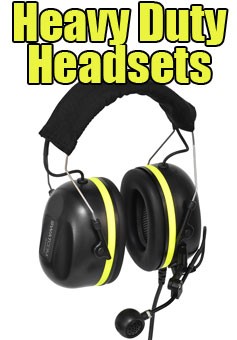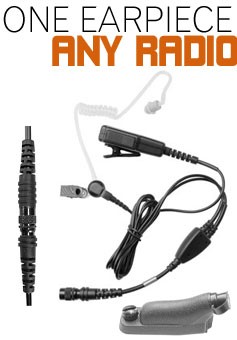
In the symphony of industry and construction, the hum of progress often reaches levels that are not just distracting, but harmful. That's where ear defenders step in as avatars of auditory safety, sealing out the cacophony of high decibels clamoring for your attention. But their role extends far beyond being simple sound barriers; they are precision-engineered guardians of your sensitive auditory mechanisms. For a distressingly loud workplace or an environment where sound is continual and consistent, understanding what ear defenders can do, how they work, and which to choose is key to both personal well-being and productivity.
Ear Defenders 101: The Mechanisms of Hearing Protection
Ear defenders, or earmuffs, are designed to reduce the intensity of sound that reaches the ear, thereby protecting the wearer's ears from hearing damage. The two main types of ear defenders are passive and active. Passive ear defenders use sound-dampening materials to provide a physical barrier to sound waves. Active ear defenders, on the other hand, utilize electronic components to cancel out noise through phase cancellation.
The Science Behind Sound Reduction
When sound waves hit the ear's protective structures – the ear canal and eardrum – these waves are amplified and directed further into the ear, stimulating the tiny hair cells within the cochlea. Noise-induced hearing loss (NIHL) occurs when these hair cells are damaged by loud sounds. Ear defenders aim to prevent this by reducing the intensity of noise before it reaches the ear. Passive ear defenders operate on the principle of sound attenuation, using materials like foam, cloth, or plastic to absorb and reflect sound waves away from the ear.
Active Noise Cancellation Technology
Active noise canceling (ANC) ear defenders, a relatively modern innovation, take hearing protection into the electronic age. These ear defenders use an external microphone to pick up sound and create a sound wave 180 degrees out of phase with the sound wave entering the ear. When the two waves meet, they cancel each other out, reducing the overall noise heard by the wearer.
Choosing the Right Ear Defenders for Your Environment
Selecting the appropriate ear defenders is not a one-size-fits-all endeavor. Several factors need consideration, including the decibel level of noise, the type of work being undertaken, and the comfort preferences of the individual.
Understanding Noise Reduction Ratings (NRR) and SNR
To gauge the effectiveness of ear defenders, look to the Noise Reduction Rating (NRR) or Sound Reduction Rating (SNR). These metrics indicate the level of noise attenuation the ear defenders can provide in decibels. A higher NRR or SNR rating means better protection, although it's important to remember that these are standardized laboratory measurements and that real-world effectiveness can vary depending on the individual, the fit of the ear defenders, and other factors.
Application-Specific Protection
Not all ear defenders are created equal, and likewise, not all environments require the same degree of protection. For example, construction sites with heavy machinery will necessitate ear defenders with a higher NRR than an office with moderate background noise.
Comfort is Key
PPE is only effective if it's worn, and this holds true for ear defenders as well. If the ear defenders are uncomfortable, they're more likely to be removed or worn incorrectly, which diminishes their protective capabilities. Look for ergonomic designs with ample padding, adjustable headbands, and ear cushions that seal out noise without causing discomfort over long periods.
Maintaining and Caring for Your Ear Defenders
Like any piece of personal protective equipment, ear defenders require maintenance to function effectively and to prevent the spread of infections.
Keeping Ear Defenders Clean
Regular cleaning of ear defenders is crucial, especially if they're shared among workers. Use mild soap and water to clean the ear defenders and allow them to dry thoroughly before use. For electronic ear defenders, follow the manufacturer's instructions on cleaning and maintenance to avoid damaging the internal components.
Checking for Wear and Tear
Inspect ear defenders for signs of damage or wear regularly. This includes looking for cracks in the ear cups, fraying in the headband, or any other issues that could compromise the integrity of the hearing protection. If you notice any damage, replace the ear defenders immediately.
Proper Storage
Proper storage can extend the life of your ear defenders. Keep them in a clean, dry area where they won't be crushed or damaged. Storing them in a case can be ideal, especially if they're going to be transported frequently.
Legislation and Best Practices for Using Ear Defenders
Understanding the regulations and best practices around the use of ear defenders is important for both employers and employees alike.
Legal Requirements
In many countries, there are legal requirements for the provision and use of ear defenders in noisy environments. Employers have a duty to protect the hearing of their workers and must provide suitable hearing protection if noise levels exceed specified limits. Employees, meanwhile, must use the provided ear defenders correctly and report any issues or discomfort.
Training and Awareness
Proper training and awareness can go a long way in ensuring the effective use of ear defenders. Informing workers about the dangers of noise, how to use ear defenders correctly, and recognizing the signs of hearing damage can promote a culture of safety in the workplace.
Fit Testing
Just as with other types of PPE like respirators, fit testing can help ensure that ear defenders are providing the necessary protection. This can involve a simple check to ensure that the ear defenders are sealing fully against the head and there are no gaps through which sound can penetrate.
Supplementary Technology and Strategies for Hearing Protection
In addition to ear defenders, there are other methods and technologies that can be used to protect workers' hearing.
Substitution and Engineering Controls
The first line of defense against workplace noise is to eliminate or reduce the noise at the source. This can include using quieter equipment, maintaining machinery properly to prevent rattles and vibrations, and even building soundproof enclosures around particularly noisy operations.
Awareness and Monitoring
Heightened awareness of noise exposure and its effects, combined with regular monitoring of employees' hearing, can help identify and address any issues early. This might involve periodic audiological assessments or using personal noise dosimeters to track individual exposure.
Hearing Conservation Programs
Employers can implement comprehensive hearing conservation programs that combine all these elements – proper ear defender use, engineering controls, monitoring, and employee education – to create a workplace that not only adheres to regulations but actively works to preserve employees' hearing health.
In conclusion, ear defenders are more than just accessories; they are crucial tools in ensuring a safe and productive work environment. By understanding what ear defenders can do, how to choose the right ones, and how to care for them properly, individuals and organizations can significantly reduce the risks associated with noise-induced hearing loss. It's a small step for your ears, but a giant leap for auditory protection.
-

Shooting Ear Defenders
The Shooting Ear Defenders are highly effective, offering an SNR of 27dB fo...
-

Peltor Ear Defenders
these Peltor ear defenders are engineered for maximum comfort and durabilit...
-

-

Childrens Ear Defenders
Our Children's Ear Defenders offer unparalleled hearing protection, comfort...
-

Adult Ear Defenders
Small: Offers a protection level up to 24db, suitable for moderate noise e...





















